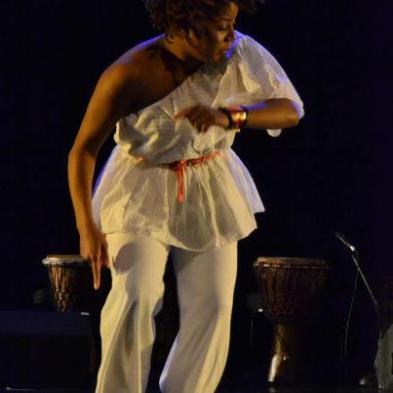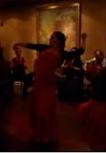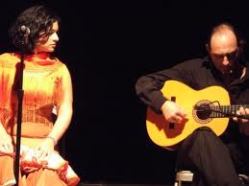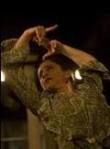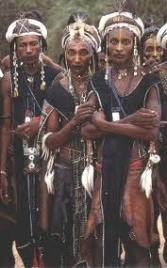This Past Saturday I attended an amazing show at the Painted Bride in Philadelphia. Kulu Mele, a local West African Dance Company (founded in 1969) and The Requisite Movers, which is a younger company created in 2010 to support the work on black female movement artists. Apart from being a breathtaking and all-sense-absorbing performance, it was particularly meaningful to me to finally see many of the teachers and dancers I have had class with on stage.
Flamenco by Tito y Anna Rubio at Bar Ferdinand
Tonight I went out to dinner with a handful of friends to celebrate our friend Jenna’s birthday. We went to get some tapas and sangria at Bar Ferdinand on 2nd street near the Piazza. The food was amazing, much better than I had remembered it and then my sister alerted me to the fact that she had just seen a woman in full flamenco attire walk by behind me. I, of course because I am obsessed with flamenco dance, got up immediately to see if there was going to be a performance. I was delighted, they were dancing. First a male dancer started and then the younger female dancer (who apparently is the daughter of the director and studies at the University of the Arts) joined him. She was a pleasure to watch, her posture and expressions conveyed a true immersion into flamenco dance/culture. Later, the older female dancer joined in, Anna Rubio, and she demonstrated both great power and grace. After the performance, I spoke with Anna Rubio and she eagerly informed me that she offers classes at a local studio as well as at the University of the Arts. She then gave me her card (see info below) and I cannot wait to try her class!
Tito y Anna Rubio
Antonia Cruz Arias
http://www.flamencodelecuentro.com
915 Hoffman St. Phila, PA 19148
267-738-6451
Teaching Salsa Dance (Oct 24th)
Today was such an enjoyable salsa class at the Main Line School Night. My students are really becoming more and more confident dancers. I was impressed to see how much of our couple routine they rememebered and had improved. Today we even danced to faster music and it seemed that they enjoyed the speed of the songs. They have memorized about ten 8 counts worth of couple choreography and we even added fun styling for both the men and women. The men struggled with their crazy leg styling and should shimmy but I think they enjoyed it. Most of the women did really well with their booty roll on 5,6,7. It is so fun to see them getting better and better and I think finally today, they even felt impressed with themselves!
West African Dance at Studio 34 with Assumane
Today I trecked all the way to West Philly (4522 Baltimore Avenue Philadelphia, PA 19143) to attend one of my favorite West African dance classes. The teacher, Assumane, who is from Guinne Bissau, exudes nonstop joy and love of dance and people during his instuction. His wife, Nikki, also dances and is welcoming to everyone who takes the class. Today we work on a dance called Fulani. Fulani comes from the Fulani people group of Africa. Their original origin is highly disputed and they are disperse all throughout Africa, making them a minority in every African country in which they reside. Below you will see a picture of a Fulani people:
The Fulani dance is a high energy dance that we were expected to learn quickly. I have discovered that most West African dance instructors choose not to break things down a great deal. There is, I’ve learned, merit to their method. Sometimes if you just go for a step you will be able to do it much for effectively than if you had been allowed the time to overthink it. We might end up getting the steps but we will take longer to learn the rhythm, the most important part of African dance. Even if the subtleties of the movement are not all in tact right away, perfection of the movement will come over time.
Yoga and Body Awareness
Today I ventured out into my neighborhood, Fishtown, and took a class at Amrita Studio on Frankford Avenue. It was an Amrita Flow class with Heather Rice. Proprioception is a word she used to describe the way in which we should strive to hold our poses without having to look to know we are doing them correctly. She also spoke about chakras and gave us a couple different chants that went with each chakra: Lam, Vam, Rum, Yum, Hum, OM. I did notice that when we repeated each mantra a couple of times I could feel the vibration in the correlating location in my body.
DANCERS AS DANCE WRITERS
DANCERS AS DANCE WRITERS
Traditionally, dancers–especially classical dancers, who commit to their profession in childhood or adolescence–had the reputation of being essentially physical creatures and thus nonverbal. Even when it was admitted that they might be intelligent, they were still often labeled “dumb” in the sense of “mute.” This myth has constantly been challenged. Today, the argument for the articulate dancer is strengthened further by the fact that dancers in ever-increasing numbers are finding their voice through writing about dancing–and editing dance publications as well.
A look at veteran writers on the New York scene alone reveals precedents. Deborah Jowitt, longtime chief dance critic at the Village Voice, with several books to her credit, began as a dancer and choreographer. The well known dance historian Nancy Reynolds was a member of the New York City Ballet. Gus Solomons jr, who danced with Merce Cunningham and still performs with a chamber group of senior artists, reviews dance regularly for Metro Daily and Gay City News. A generation before them, Edwin Denby, arguably the most gifted English-language dance critic, also started his career on stage. Distinguished dance writers like David Vaughan, Nancy Goldner, and Mindy Aloff never had a full-fledged stage career but were dedicated dance students.
Casting the net farther back in time and wider in space reveals a slew of worthy books written by dancers. The most natural form for the dancer who sits down and takes pen in hand is, of course, the memoir. Dancers recording their own lives and careers fall into two groups–the “as told to”s (in which a collaborator’s hand grasps the pen) and those who go the course independently.
In the first category, Suzanne Farrell composed her Holding on to the Air with the help of Toni Bentley, a former New York City Ballet dancer who has published several of her own books. But Tamara Karsavina’s Theatre Street, arguably the most evocative and touching of all dance memoirs, is said to have been written by the Maryinsky ballerina herself–and in her adopted language, English.
Allegra Kent, the most poetic of Balanchine’s ballerinas, found her own voice in prose for Once a Dancer . . . . Twyla Tharp’s voice (blunt, tough, and intermittently ecstatic) is authentic in her autobiographical Push Comes to Shove, as is Margot Fonteyn’s (exquisitely tactful) inAutobiography. In both cases, the personality in prose closely resembles the woman’s dance temperament. Paul Taylor (Private Domain) and Agnes de Mille (Dance to the Piper) produced books that resonated beyond the confines of the dance world–his for its literary distinction, hers for its vitality and human interest.
Why, then, have dancers have been considered functionally illiterate, inarticulate, or both? One reason is that, with few exceptions, classical dancers must begin their training as children. The ideal age is eight, when ordinary kids are in third grade. If the training is serious–that is, career-oriented–their academic education naturally takes second place. Until the mid-twentieth century, in the state-run ballet academies that feed into Europe’s grandest troupes, the education provided alongside the rigorous dancing lessons was at times perfunctory. In the States, youngsters often studied via correspondence courses, which could be sketchy. Even at best, these studies cut off at the high school level, since that’s when a successful ballet student begins his or her stage career. By contrast, the last decade has witnessed a significant surge in the number of dancers in earning college degrees, during as well as after their performing years.
Again, until fairly recently, the traditional modus operandi in ballet companies was a dictatorship imposed by a powerful director or choreographer upon dancers whose voiced opinions were implicitly if not overtly discouraged. The performing artists, cultivated for their bodies, not their brains–as if the two were separate entities–understood that they were to “shut up and dance.”
Modern dance, a field in which a performer can begin as a young adult, is not so exigent. Still, like their classically trained cousins, these contemporary dancers pass most of their working hours in silence. In daily class, rehearsal, and performance they are rarely required, let alone encouraged, to speak.
Times have changed, however, and today’s trend toward self-empowerment has permeated the ivory towers and prison walls that once sheltered dance (or, depending on how you look at it, cut it off) from many worldly realities. More and more, dancers, are speaking out and, having found their voice, writing–commenting on, judging, and influencing the activities in their profession.
This social evolution has combined with the resources of the Internet to make today’s dancers more articulate than their predecessors. Anyone with a computer and access to cyberspace can set up shop on the Net, cost-free, in something like twenty minutes and publish what he has to say, bypassing (at his peril, of course) the roadblocks of editors. Rachel Feinerman’s blog (www.downtowndancer.com) and the choreographer Leigh Witchel’s (www.leighwitchel.com/blog) are highly developed examples of such letters to the world.
The most thoroughgoing dance publication on the Internet, however, is currently being done at the DanceView Times www.danceviewtimes.com), originated and run by Alexandra Tomalonis, and The Dance Insider (www.danceinsider.com), originated and run by Paul Ben-Itzak and his colleagues. Both sites feature reviews of a wide spectrum of dance by a regular stable of writers, professional dancers among them. The Dance Insider, as its name suggests, makes a point of engaging dancers as writers. The Danceview Times is more eclectic. “I’m interested in finding and using vivid writers,” Tomalonis says. “Their background may be in dancing–or in history, theater, literature, or music. Each one brings something interesting and meaningful to the mix.”
The more traditional realm of print publication includes two major dance journals whose editors in chief are well known former dancers. Dance magazine, the most lavish and widely read periodical of its kind, is run by Wendy Perron, a postmodern dancer and choreographer, who still performs and choreographs occasionally. Virginia Johnson, former ballerina of Dance Theatre of Harlem, edits Pointe magazine.
Perron, who also teaches seminars in dance writing–a phenomenon that has recently seen great increase in interest–uses this tactic to enable dancer-writers in the making: “I encourage them to bring the equipment they have as dancers to their writing. First, their highly developed sense of rhythm and phrasing. Then, their ability to communicate, as they do on stage.”
Among the relative newcomers whom Perron publishes are Lisa Kraus, an independent postmodern dancer and choreographer, whose style is lush and visceral; Lise Rinehart, a former American Ballet Theatre soloist, a paragon of clarity who also writes for the DanceView Times; and Rosalynde LeBlanc, a veteran of Mikhail Baryshnikov’s White Oak Dance Project, whose writing style recalls Agnes de Mille’s in its freshness and vigor.
Johnson is actively trying to encourage dancer-writers. Among her recruits is Tai Jimenez, a veteran of Dance Theatre of Harlem, now a principal with Boston Ballet, whose articles reveal her spiritual orientation and her sensitivity to racial issues.
“A dancer who writes,” Johnson believes, “is especially good at helping an audience understand how a performer makes choreography expressive–how she takes the steps, stuff so cut and dried you could notate it, and infuses them with feeling.”
Not surprisingly, the newly minted dancer-writers are nimble at expressing their reasons for taking up a second trade. Kraus says, “I need to be more involved with dance than simply watching it. If I’m not in it–performing in it or another aspect of creating it–I very much like to take it home with me and dwell with it.”
LeBlanc, who has produced some eloquent personal essays, explains, “For me, writing is instinctive–the thing I do behind closed doors at the end of the day to fall into synch with my own drummer. Dancing has always been the cerebral struggle for me, and it is only by writing about that struggle that I have chosen again and again to keep dancing.”
It’s evident, of course, that a writer needn’t have danced to write well about dancing. The achievement of the non-dancing Arlene Croce, called “the Jane Austen of dance,” settles that question for good. But it can certainly be argued that a dance writer’s understanding is enlarged by firsthand experience of what is involved in getting the body to speak worlds.
Teaching Salsa Dance
Currently, I teach a salsa class of about ten students at Main Line School Night. When I was 18 I saw couples dance salsa for the first time, I was amazed at the beauty of seeing these men and women move in such harmony and be so playful. It was a salsa club in Oaxaca, Mexico and it was called La Candela. It is still so vivid to me. They were all so beautiful. I never imagined that one day I would be showing couples in the US to step and shake to these rhythms.
Through teaching I am learning that everybody enjoys the playful parts of salsa: the shimmies, the body roles, the hip pops, the hand tosses, the change of direction etc. Wives like it when I tell their husbands that they need to lead differently, “Put your hand here, not here” or “Turn her on 5 not on 3.” Husbands like it when I tell their wives that they need to follow differently, “Give him more tension, he can’t lead you floppy” or “Stay in relevé, it will make it easier for him to turn you.” My class is an interesting mix of personalities and backgrounds. Although most are older married couples, I do have one 19 year old Italian nanny who is, “bored out of her mind so she just had to do something,” and now she is taking salsa.
Main Line School Night has invited me back for the Spring so I look forward to coming up with more material to teach and seeing some of the same students again.
Why Write About Dance?
Dance, for many, is a foreign language spoken using unusual means, the whole body! On the other hand, it is something that, for the dancer, is not necessarily articulated in words. In this way, if these movements are expressed in language the dancer can perhaps see them in a new light, from a new angle. I am a dancer and a writer. As I am still relatively young, I feel the urgency to dance, to use my body while it still feels good and while I still have the freedom. However, the writer in me pulls me to moments of reflection and urges me to slow down, not to rush life away. So, I am drawn to dance and to write about dance: reflect on it, preserve it, dissect it and slow it down through description. In this blog you will find my thoughts/critiques of the dance experiences I have here in Philadelphia, PA.
